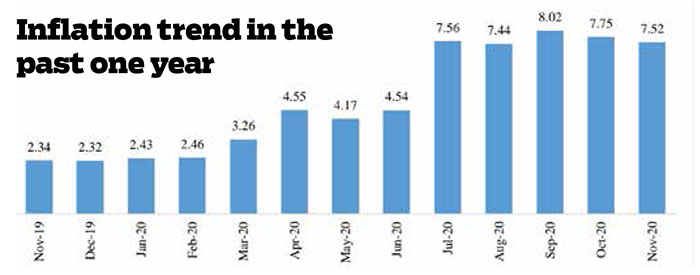
Purchasing power of the Nu drops by 6.99 %
MB Subba
Inflation has slowed down as of November after a record high in September 2020 when commodity prices were sent ratcheting by the Covid-19-induced disruptions in food supplies.
The year-on-year consumer price index (CPI) decreased to 7.52 percent in November 2020 from 8.02 percent in July of the same year, which was the highest inflation rate of last year, according to the National Statistics Bureau (NSB) report released on January 22.
Increase in price of commodities during the current lockdown is not included as the report is published quarterly. The lockdown came into effect on December 20.
The year-on-year prices of food items such as meat, vegetables, fruits, and dairy products increased by 20-30 percent in November.
The year-on-year prices of betel nuts and betel leaves also increased by 22 percent in November. Non-food prices went up by 1.72 percent on an average.
According to the NSB report, clothing and footwear recorded the highest increase of 5.16 percent in the non-food category, followed by health and housing which increased by 3.30 percent and 3 percent respectively.
With the increase in prices, the purchasing power of the Ngultrum (PPN) as measured by CPI is Nu 66 as of October 2020 compared to December 2012. This means, Nu 100 in October 2020 is worth only Nu 66 at December 2012 prices.
The PPN has dropped by 6.99 percent in the past 12 months (from November 2019 to November 2020) due to price increase in the economy.
The CPI is a measure of average price changes in the basket of goods and services purchased by households over time. It shows how much, on average, prices of goods and services have increased or decreased from a particular reference period.
According to NSB, the CPI covers goods and services consumed by households and samples of goods and services are selected using the household expenditure data to measure the inflation experienced by the households.
Prices of the sampled goods and services are collected from urban areas in 20 dzongkhags on monthly, quarterly and annual frequency depending on the price volatility of the items.

